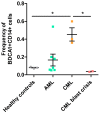BDCA1+CD14+ Immunosuppressive Cells in Cancer, a Potential Target?
- PMID: 30235890
- PMCID: PMC6161086
- DOI: 10.3390/vaccines6030065
BDCA1+CD14+ Immunosuppressive Cells in Cancer, a Potential Target?
Abstract
Dendritic cell (DC) vaccines show promising effects in cancer immunotherapy. However, their efficacy is affected by a number of factors, including (1) the quality of the DC vaccine and (2) tumor immune evasion. The recently characterized BDCA1+CD14+ immunosuppressive cells combine both aspects; their presence in DC vaccines may directly hamper vaccine efficacy, whereas, in patients, BDCA1+CD14+ cells may suppress the induced immune response in an antigen-specific manner systemically and at the tumor site. We hypothesize that BDCA1+CD14+ cells are present in a broad spectrum of cancers and demand further investigation to reveal treatment opportunities and/or improvement for DC vaccines. In this review, we summarize the findings on BDCA1+CD14+ cells in solid cancers. In addition, we evaluate the presence of BDCA1+CD14+ cells in leukemic cancers. Preliminary results suggest that the presence of BDCA1+CD14+ cells correlates with clinical features of acute and chronic myeloid leukemia. Future research focusing on the differentiation from monocytes towards BDCA1+CD14+ cells could reveal more about their cell biology and clinical significance. Targeting these cells in cancer patients may improve the outcome of cancer immunotherapy.
Keywords: BDCA1+CD14+ cells; cancer; cancer immunotherapy; dendritic cells; immune suppression; tumor microenvironment.
Conflict of interest statement
The authors declare no conflict of interest. The funders had no role in the design of the study; in the collection, analyses, or interpretation of data; in the writing of the manuscript, and in the decision to publish the results.
Figures



Similar articles
-
Expansion of a BDCA1+CD14+ Myeloid Cell Population in Melanoma Patients May Attenuate the Efficacy of Dendritic Cell Vaccines.Cancer Res. 2016 Aug 1;76(15):4332-46. doi: 10.1158/0008-5472.CAN-15-1695. Epub 2016 Jun 20. Cancer Res. 2016. PMID: 27325645
-
Hepatitis B Virus Surface Antigen Activates Myeloid Dendritic Cells via a Soluble CD14-Dependent Mechanism.J Virol. 2016 Jun 24;90(14):6187-6199. doi: 10.1128/JVI.02903-15. Print 2016 Jul 15. J Virol. 2016. PMID: 27099316 Free PMC article.
-
Transcriptional Classification and Functional Characterization of Human Airway Macrophage and Dendritic Cell Subsets.J Immunol. 2017 Feb 1;198(3):1183-1201. doi: 10.4049/jimmunol.1600777. Epub 2016 Dec 28. J Immunol. 2017. PMID: 28031342 Free PMC article.
-
Cancer Vaccines in the World of Immune Suppressive Monocytes (CD14(+)HLA-DR(lo/neg) Cells): The Gateway to Improved Responses.Front Immunol. 2014 Apr 4;5:147. doi: 10.3389/fimmu.2014.00147. eCollection 2014. Front Immunol. 2014. PMID: 24772111 Free PMC article. Review.
-
The CD14+HLA-DRlo/neg Monocyte: An Immunosuppressive Phenotype That Restrains Responses to Cancer Immunotherapy.Front Immunol. 2019 May 22;10:1147. doi: 10.3389/fimmu.2019.01147. eCollection 2019. Front Immunol. 2019. PMID: 31191529 Free PMC article. Review.
Cited by
-
Stiffness regulates dendritic cell and macrophage subtype development and increased stiffness induces a tumor-associated macrophage phenotype in cancer co-cultures.Front Immunol. 2024 Aug 15;15:1434030. doi: 10.3389/fimmu.2024.1434030. eCollection 2024. Front Immunol. 2024. PMID: 39211033 Free PMC article.
-
The Therapeutic Potential of Tackling Tumor-Induced Dendritic Cell Dysfunction in Colorectal Cancer.Front Immunol. 2021 Oct 6;12:724883. doi: 10.3389/fimmu.2021.724883. eCollection 2021. Front Immunol. 2021. PMID: 34691029 Free PMC article. Review.
-
Research progress on dendritic cell vaccines in cancer immunotherapy.Exp Hematol Oncol. 2022 Jan 24;11(1):3. doi: 10.1186/s40164-022-00257-2. Exp Hematol Oncol. 2022. PMID: 35074008 Free PMC article. Review.
-
Tolerogenic Dendritic Cell-Based Approaches in Autoimmunity.Int J Mol Sci. 2021 Aug 5;22(16):8415. doi: 10.3390/ijms22168415. Int J Mol Sci. 2021. PMID: 34445143 Free PMC article. Review.
-
Therapeutic Vaccines and Cancer Immunotherapy.Vaccines (Basel). 2020 Oct 10;8(4):596. doi: 10.3390/vaccines8040596. Vaccines (Basel). 2020. PMID: 33050488 Free PMC article.
References
Publication types
Grants and funding
LinkOut - more resources
Full Text Sources
Other Literature Sources
Research Materials

